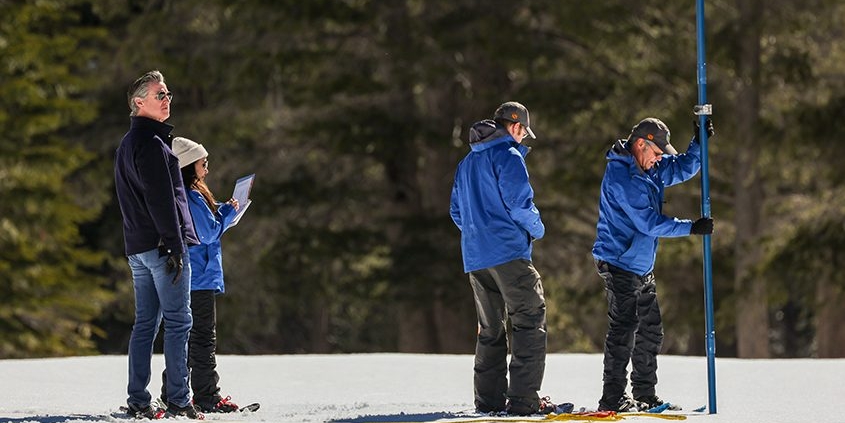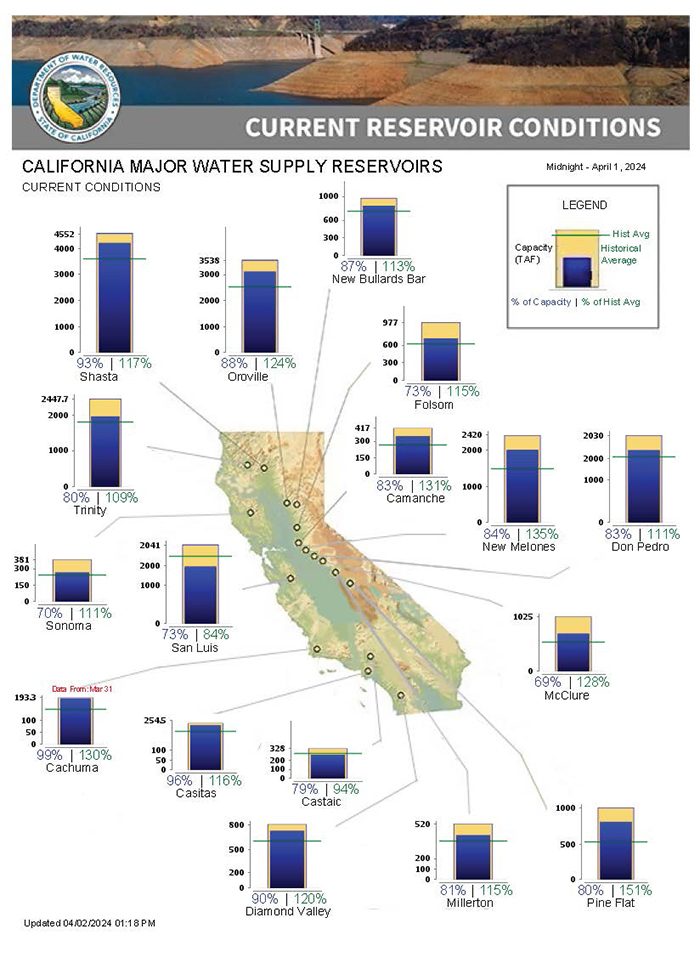 (Left to right) Gov. Gavin Newsom watches Angelique Fabbiani-Leon, State Hydrometeorologist, Water Resources Engineers Anthony Burdock and Andy Reising during the fourth media snow survey of the 2024 season held at Phillips Station in the Sierra Nevada. The survey is held approximately 90 miles east of Sacramento off Highway 50 in El Dorado County. Photo: Andrew Nixon, California Dept. of Water Resources
(Left to right) Gov. Gavin Newsom watches Angelique Fabbiani-Leon, State Hydrometeorologist, Water Resources Engineers Anthony Burdock and Andy Reising during the fourth media snow survey of the 2024 season held at Phillips Station in the Sierra Nevada. The survey is held approximately 90 miles east of Sacramento off Highway 50 in El Dorado County. Photo: Andrew Nixon, California Dept. of Water Resources
Snow Survey Confirms Water Supplies Remain Plentiful for San Diego
The California Department of Water Resources performed its fourth snowpack survey of the season on Tuesday, April 2, confirming that the early winter’s “snow drought” gave way to a slightly above-normal snowpack following a series of storms.
DWR’s early April snow survey marks what is considered the peak snowpack for the year in the Sierra Nevada. The Colorado River Basin – San Diego County’s main source of water – also reports more snow than average for this time of year.
DWR’s survey recorded 64 inches of snow depth and a snow water equivalent of 27.5 inches, which is 113 percent of the average. The snow water equivalent measures the amount of water contained in the snowpack and is a key component of DWR’s water supply forecast.
Two consecutive wet winters, combined with regional investments and conservation by residents and businesses, delivered enough water to meet the San Diego region’s needs for the rest of 2024.
Wet Winter and Full Reservoirs Support Region
Across California, reservoirs are nearly full as we approach the start of summer—the heaviest water-use months. Plentiful water is a rare occurrence in the arid Southwest. From 2020 to 2022, the state suffered severe drought conditions that forced water-use reductions for millions of California residents.

California’s major reservoirs are between 69 and 99 percent of capacity as of April 1. Graphic: California Dept. of Water Resources
For the past decade, San Diego County has been insulated from drought-induced cutbacks due to the long-term investments in secure water supplies, a strategy that emerged in the early 1990s following an economically devastating drought. Since 1990, the region has dramatically cut water demands, reducing per capita water use by more than 50 percent. Water conservation has become a “way of life” for the region’s residents and businesses.
Innovative Leadership in Water Management
The Water Authority is currently working to sell or transfer some of its surplus water supply to areas with greater needs. For instance, an innovative water transfer deal could eventually deliver drought-resilient water supplies to South Orange County through the Moulton Niguel Water District and help combat increasing water rates for San Diegans.
A deal completed in late 2023 saved the San Diego region about $20 million. These water transfers help maintain the viability of the Colorado River as the most critical water resource for the Southwest.
“Wet years are the right time to prepare for the inevitable dry years,” said Water Authority General Manager Dan Denham. “That’s why we’re working every day to explore creative deals that help us reduce water rate pressures for San Diegans, enhance our long-term water security, and help our neighbors meet their needs for drought-resilient water supplies.”
(Editor’s Note: Information in this story was provided by the California Department of Water Resources).



